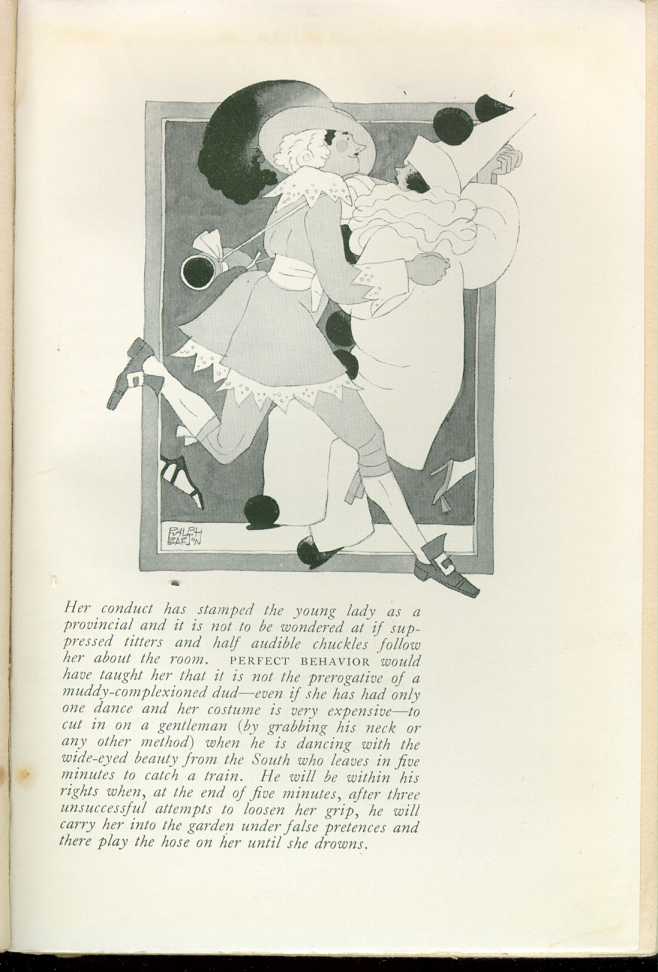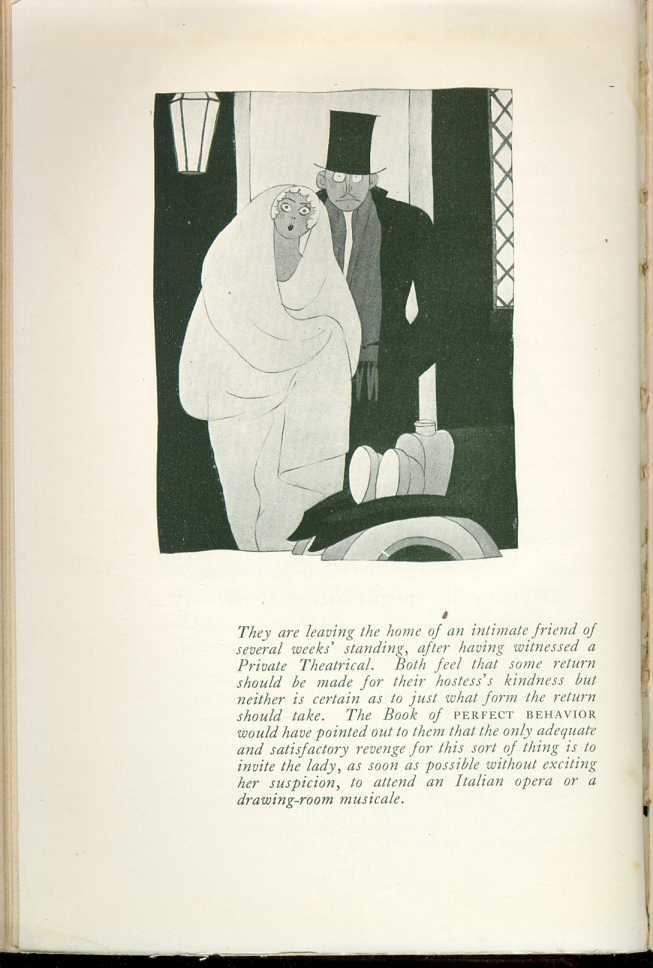|
CHAPTER THREE: THE ETIQUETTE OF TRAVEL
Perfect Behavior | ||
GOOD FORM ON A STREET CAR
LET us, first of all, however, take up some of the simpler forms of rail transportation, such as, for example, the electric street or "tram" car now to be seen on the main highways and byways of all our larger cities. The rules governing behavior on these vehicles often appear at first quite complicated, but when one has learned the "ropes," as they say in the Navy, one should have no difficulty.
An elderly lady with a closed umbrella, for example, desiring to take a street car, should
When this happens the elderly lady should get quietly up from the street and stand outside the door marked "Exit Only" until the motorman opens it for her. She should then enter with the remark, "I signalled to three cars and not one of them stopped," to which the motorman will reply, "But, lady, that sign there says they don't stop on this corner." The
After taking his number she should enter the car. At the opposite end of the vehicle there will undoubtedly be three or four vacant seats; instead of taking one of these she should stand up in front of some young man and glare at him until he gets up and gives her his place.
It is not customary in American cities for ladies to thank gentlemen who provide them with seats.
After a few minutes she should turn to the man at her right and ask "Does this car go to Madison Heights?" He will answer "No." She should then turn to the man on her left and ask "Does this car go to Madison Heights?" He will answer "No." Her next question—"Does this car go to Madison Heights?"—should be addressed to a man across the aisle, and the answer will be "No." She should then listen attentively while the conductor calls out the names of the streets and as he shouts "Blawmnoo!" she should ask the
It is then correct for her to pickup her umbrella and, carefully waiting until the conductor has pulled the "go ahead" signal, she should cry "Wait a minute, conductor—I want to get off here." The car will then be stopped and she should say "Is this Madison Heights?" to which the conductor will reply "This ain't the Madison Heights car, lady." She should then say "But you called out Madison Heights," to which he will answer "No, lady—that's eight miles in the opposite direction." She should then leave the street car,

Her conduct has stamped the young lady as a provincial and it is not to be wondered at if suppressed titters and half audible chuckles follow her about the room. PERFECT BEHAVIOR would have taught her that it is not the prerogative of a muddy-complexioned dud—even if she has had only one dance and her costume is very expensive—to cut in on a gentleman (by grabbing his neck or any other method) when he is dancing with the wide-eyed beauty from the South who leaves in five minutes to catch a train. He will be within his rights when, at the end of five minutes, after three unsuccessful attempts to loosen her grip, he will carry her into the garden under false pretences and there play the hose on her until she drowns.
[Description: Drawing of a man and woman dressed in costumes dancing. ]
They are leaving the home of an intimate friend of several weeks' standing, after having witnessed a Private Theatrical. Both feel that some return should be made for their hostess's kindness but neither is certain as to just what form the return should take. The Book of PERFECT BEHAVIOR would have pointed out to them that the only adequate and satisfactory revenge for this sort of thing is to invite the lady, as soon as possible without exciting her suspicion, to attend an Italian opera or a drawing-room musicale.
[Description: Drawing of a man in a coat and tophat and a woman in a shawl standing next to a car with their eyes wide open. ]The above hints for "tram" car etiquette apply, of course, only to elderly ladies. For young men and women the procedure would be in many cases quite different. A young married woman, for example, on entering a street car, should always have her ticket or small "change" so securely buried in the fourth inside pocketbook of her handbag that she cannot possibly find it inside of twelve minutes. Three or more middle-aged ladies, riding together, should never decide as to who is to pay the fare until the conductor has gone stark raving mad.
|
CHAPTER THREE: THE ETIQUETTE OF TRAVEL
Perfect Behavior | ||